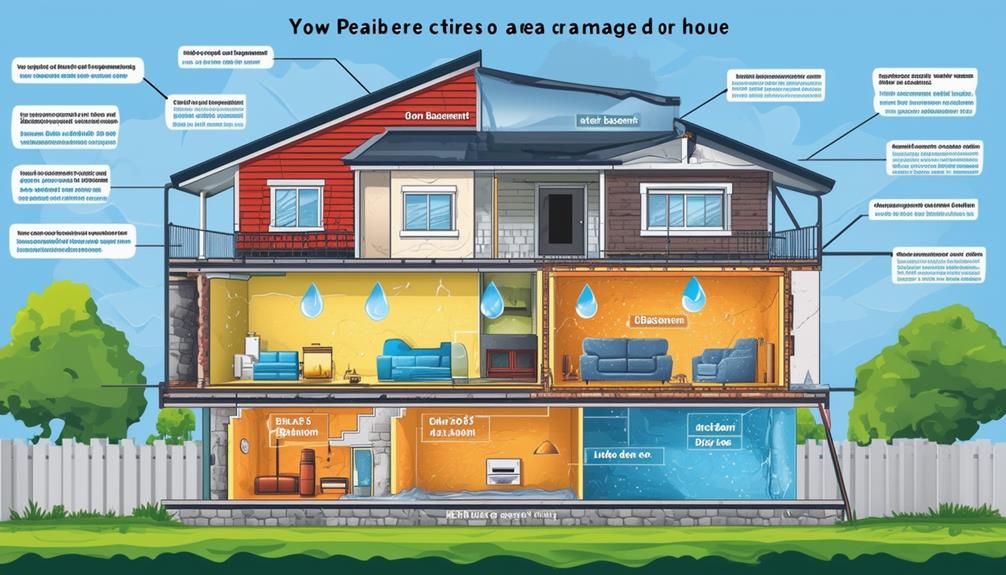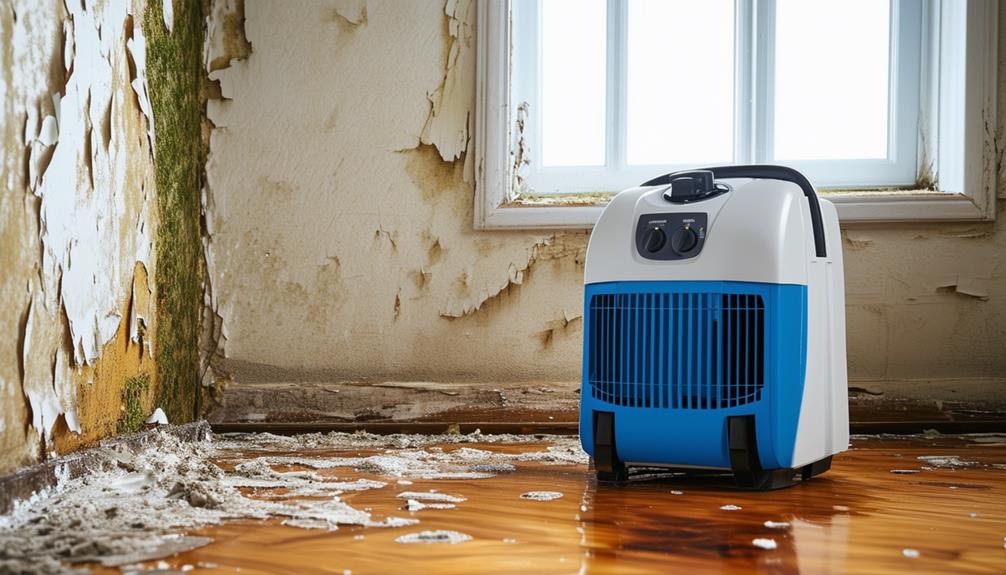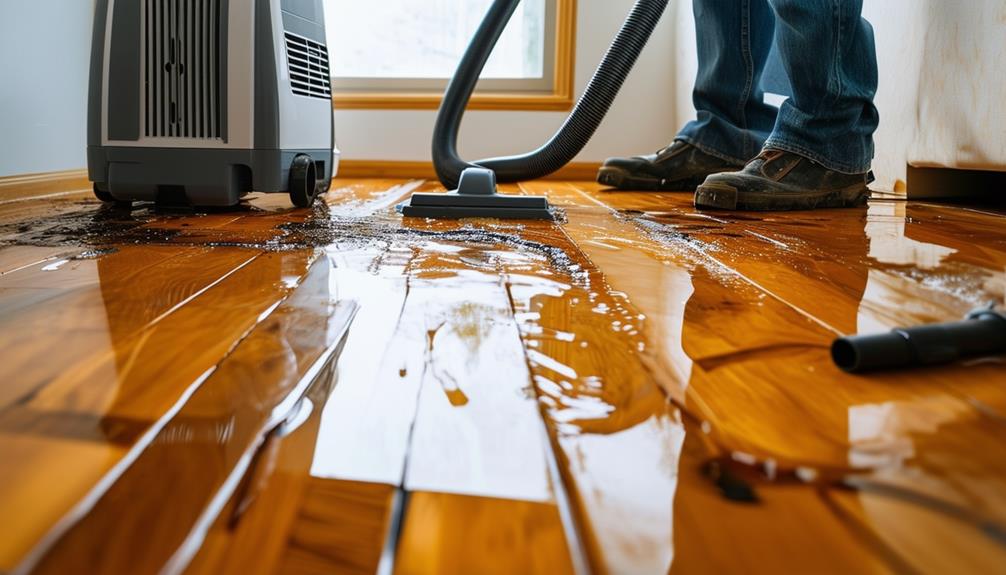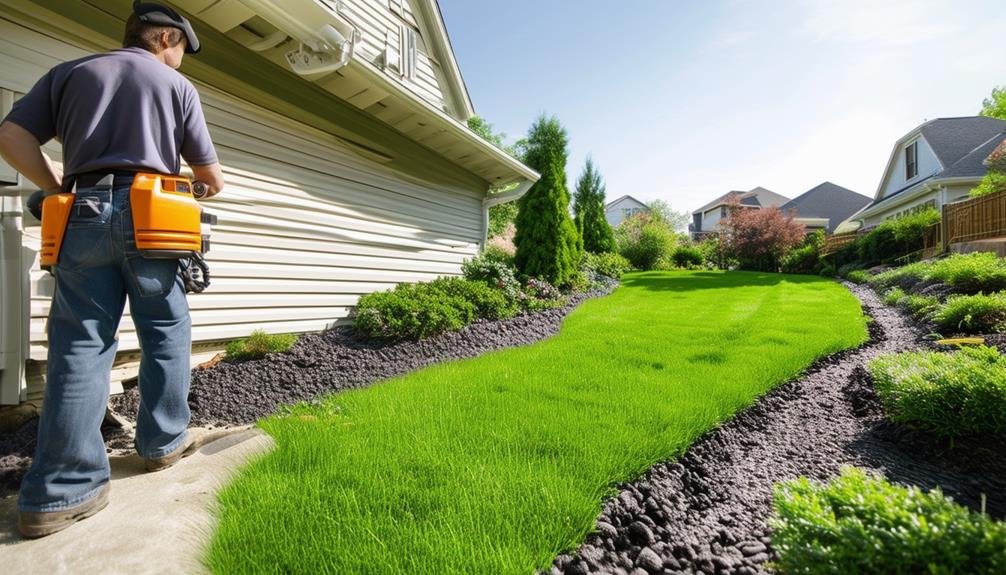As a homeowner, you should know that water damage, often caused by leaks or severe weather, comes in different levels of severity that impact restoration needs. Detecting leaks early and taking quick action prevents further damage. If you find damp patches or hear running water, it's best to consult a professional. They can provide thorough damage assessments and help with insurance claims. Do-it-yourself cleanup is possible too, involving removing standing water and drying areas thoroughly. Knowing all this, there's more you can learn about preventing future water damage and living in a safer home environment.
Understanding Water Damage

To effectively deal with water damage, it's essential that you first understand its causes, effects, and the potential risks involved. It's not just about the immediate mess. Water damage has classifications: Class 1 is minimal damage, Class 2 has a fast evaporation rate, Class 3 involves the fastest evaporation, and Class 4 requires special drying methods. Each class involves a deeper level of intrusion, from water just affecting a part of a room to soaking into walls, furniture, and more.
Understanding damage classifications helps you gauge the severity and take appropriate measures. It also plays a critical role in dealing with insurance coverage. Insurance policies can be complex and may not cover all types of water damage. You'll need to know your policy inside and out, and be prepared to advocate for yourself. Certain types of damage may require specialized coverage.
Common Causes of Water Damage
You might be surprised to learn that water damage is often caused by common household mishaps. Issues such as home water leaks, severe weather conditions, and plumbing system failures can wreak havoc if not promptly addressed. As we move forward, we'll examine each of these causes to help you understand and prevent potential water damage in your home.
Identifying Home Water Leaks
Leaks in your home can originate from a variety of sources, often causing significant water damage if left unnoticed or untreated. As a part of our community of homeowners, it's crucial to be aware of potential problems and how to address them.
You can utilize several leak detection methods to identify water leaks. Listen for the sound of running water when all water-using appliances are shut off. Look for damp patches or mold on walls, floors, or ceilings. A sudden increase in your water bill can indicate a leak.
Once you've detected a leak, prompt action is key in repairing leak damages. Turn off the water supply to prevent further damage. If you're comfortable doing minor repairs, you may be able to fix the issue yourself. Nevertheless, for large leaks or if you're unsure, a professional plumber should be called.
Weather-Related Damage Risks
While home leaks can be troublesome, inclement weather poses another significant risk for water damage in your home. The impacts of climate change are becoming increasingly evident, elevating the potential for severe weather conditions and subsequently, the threat of water damage in homes.
Here are four common weather-related causes of water damage:
- Heavy Rainfall: Persistent or heavy rains can result in water seeping into your home, particularly if there are existing vulnerabilities like cracks in the foundation or poorly sealed windows and doors.
- Hurricanes and Storms: These extreme weather events can cause severe flooding and structural damage, allowing water to infiltrate your home.
- Melting Snow and Ice: In colder climates, the thawing of snow and ice can lead to water accumulation around your home's foundation, potentially causing water damage.
- High Winds: Windstorms can damage roofs and windows, creating openings for water to enter.
Understanding these risks is important in developing a preventive maintenance plan. Moreover, it's vital to review your insurance coverage to make sure you're protected against these weather-related risks. After all, feeling secure and prepared in your home is part of creating a sense of belonging.
Plumbing System Failures
Plumbing system failures often lurk silently behind walls and beneath floors, becoming major contributors to water damage in homes. These silent saboteurs can lead to significant issues that require emergency repairs, sometimes resulting in costly renovations. It's vital to be vigilant, keeping an eye out for signs of potential plumbing issues that could lead to water damage.
Common causes include corroded pipes, loose fittings, and outdated plumbing systems. If you're living in an older home, consider plumbing upgrades as part of routine home maintenance. It's not just about keeping up with modern times, but also about preventing water damage that could be devastating to your property.
Remember, early detection of plumbing issues can save you from costly repairs down the line. Don't ignore that dripping faucet or the occasional water pressure fluctuation. These could be signs of bigger problems. Seek professional help if you're unsure about something.
Being proactive and informed about your home's plumbing system is part of being a responsible homeowner. In doing so, you're not just protecting your home, but also creating a safer, more secure living environment for you and your family. Be a part of the solution, and don't let water damage catch you off guard.
The Effects of Water Damage

Now, let's shift your focus to the effects of water damage. Being able to recognize the signs of water damage is crucial in mitigating its impact on your property. If ignored, these damages can have severe consequences, which we'll investigate in the next section.
Identifying Water Damage Signs
Your property's health may be at risk if you overlook the subtle signs of water damage, such as discolored walls, a musty smell, or unusual dampness in certain areas. These signs could indicate mold growth or even structural instability, both of which can have serious implications for your home's safety and value.
Identifying water damage signs is your first line of defense. Here are four key indicators that you should be aware of:
- Discoloration: Unusual spots or streaks on walls, ceilings, and floors often signal water damage. They might be yellow, brown, or copper in color.
- Odors: Over time, water buildup can lead to mold and mildew, which produce a musty smell. If an area of your home suddenly smells damp and musty, it's time to investigate further.
- Texture Changes: Water can warp, buckle, or bubble your walls and flooring. Any change in texture could be a sign of hidden water damage.
- Mold Growth: Mold thrives in damp environments. If you come across mold, it's likely you have an underlying water issue.
In the end, your diligence is vital. The sooner you identify and address water damage, the better you can maintain your home's health and safety.
Consequences of Ignored Damage
Ignoring these signs and failing to address water damage promptly can lead to serious, costly consequences for your property. One immediate impact is structural damage. Water seeping into your home's structure can weaken its foundation, making it unsafe and reducing its value.
The health implications of unchecked water damage are equally significant. Damp environments breed mold and mildew, which can trigger allergies, cause respiratory issues, and even lead to serious conditions like asthma.
Then there's the issue of insurance complications. Many insurance policies don't cover damage caused by neglect. If you've ignored clear signs of water damage, you might find your claim rejected, leaving you to shoulder the cost of repairs yourself.
Damage to personal items is another repercussion. Water can ruin valued possessions, including electronics, furniture, and sentimental items, which may not be replaceable.
Lastly, unaddressed water damage can lead to increased utility bills. Excessive moisture can overwork your heating, ventilation, and air conditioning system, leading to higher energy consumption.
Identifying Signs of Water Damage
To effectively mitigate water damage, it's critical to identify the telltale signs early on, such as discoloration on walls or ceilings, musty odors, or dampness to the touch. If you're vigilant, you can catch these signs before they escalate into serious issues.
- Discoloration: Water damage often manifests as yellow or brown discoloration on walls and ceilings. This is usually a sign of a persistent leak.
- Musty Odor: If you notice an unusual, musty smell in a room, it's likely caused by mold growth, a common result of water damage.
- Dampness: Areas that are consistently damp or have unexplained moisture may indicate a hidden water source.
- Mold Growth: Mold thrives in moist environments and is a clear indication of water damage. It's not only unsightly but also poses serious health impacts.
DIY Water Damage Cleanup Tips

Begin your water damage cleanup by promptly addressing the source of the leak, then move on to drying, disinfecting, and deodorizing the affected areas. It's important to act quickly to minimize damage and prevent mold growth.
After you've stopped the leak, remove any standing water with a wet vacuum or mop. Next, employ a dehumidifier and fans to accelerate the drying process. Especially with carpeted areas, use carpet drying techniques such as using a carpet cleaner to extract water, and then place a fan to dry it thoroughly. This technique not only dries your carpet but also prevents mold growth.
Don't forget to clean and disinfect all the affected areas. Wash items with hot soapy water, and then apply a disinfecting solution. This step is essential for mold growth prevention.
Lastly, deodorize the area to remove any unpleasant odors that the water may have left behind. This can be done with baking soda or a commercial deodorizing product.
Professional Water Damage Restoration
While you can tackle minor water damage issues yourself, there are instances when it's best to call in professional water damage restoration services. These professionals have the experience, skills, and tools necessary to address complex water damage situations. They can furthermore help manage restoration costs and guide you through the often complicated process of insurance claims.
When considering professional water damage restoration, remember:
- Assessment: Professionals will conduct a thorough assessment of the damage and provide a detailed repair plan.
- Advanced Techniques: They use advanced drying techniques and industrial-grade equipment to remove water quickly and prevent further damage.
- Restoration Costs: Professionals can help minimize restoration costs by preventing additional damages and employing efficient restoration methods.
- Insurance Claims: They will assist you in documenting the damages for your insurance claims, ensuring you get a fair settlement.
As a homeowner, you're part of a community of people who take pride in their homes. Seeking professional help when needed isn't just about fixing a problem; it's about maintaining the integrity of your home, protecting your investment, and preserving the sense of belonging you've worked so hard to build.
Preventing Future Water Damage

In protecting your home from future water damage, it's important to take proactive measures that can greatly reduce the risk of recurrence. Moisture control strategies are an essential part of this. Regularly inspect your home for leaks, especially in areas like the roof and plumbing systems. Make sure your home has good ventilation, as this helps prevent condensation and mold growth.
Don't forget about the significance of proper drainage. Install a good gutter system and make sure your property is graded so that water flows away from your home. These steps will go a long way in keeping unwanted water out of your house.
Moreover, understanding your insurance coverage is crucial. Not all policies cover water damage, so you need to be aware of what your policy includes and what it does not. Insurance coverage tips include reviewing your policy annually, documenting your possessions, and keeping up-to-date records of repairs and maintenance.
In the end, prevention is always better than restoration. By implementing these strategies, you're not just protecting your property, but you're also creating a safer, healthier environment for you and your loved ones. You'll enjoy peace of mind knowing you've done everything you can to prevent future water damage.
Conclusion
Like a stealthy intruder, water damage can silently wreak havoc on your home. It's important to understand its causes, identify its signs, and know how to clean up and prevent future damage. While DIY methods may suffice for minor issues, professional restoration services are indispensable for severe damage. Stay vigilant, as a well-guarded home is your best defense against this unwelcome invader. Remember, knowledge is your shield and action is your sword in this fight against water damage.
